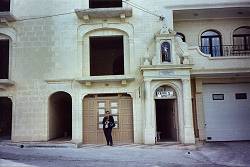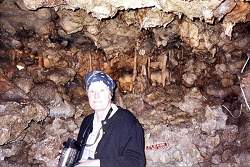Għar Xerri
Xerri’s Grotto
Useful Information

© Tony Oldham, 21-FEB-2002, with kind permission.
| Location: |
Triq l-ghar ta Xerri (Xerri’s Grotto Street), Xagħra, Gozo, Malta.
(36.051210, 14.261150) |
| Open: |
All year daily 10-18. [2023] |
| Fee: |
Adults EUR 2.50. [2023] |
| Classification: |
 Karst Cave Karst Cave
|
| Light: |
 Incandescent Incandescent
|
| Dimension: | T=19 °C. |
| Guided tours: | D=15 min, L=17 m, VR=7 m. |
| Photography: | allowed |
| Accessibility: | no |
| Bibliography: |
Trevor S. Shaw (1951):
The Caves of Gozo,
BSA Cave Science, (16) pp. 339-347.
|
| Address: | Xerri’s Grotto, Triq l-ghar ta Xerri, Xagħra, Gozo, Malta, Tel: +356-2755-2733. |
| As far as we know this information was accurate when it was published (see years in brackets), but may have changed since then. Please check rates and details directly with the companies in question if you need more recent info. |
|
History
| 1923 | discovered by Anthony Xerri when he was digging a well. |
Description
Xerri’s Grotto is a small cave with nice speleothems located below the residential building of the Xerri family. It was discovered by Anthony Xerri when he was digging a well in 1923. He developed the cave with some help by his sons. The spiral staircase down into the cvae was built into the well, so it is quite narrow, the steps are only 30 cm wide. The development works were forced by World War II, as the cave was used as an air raid shelter for the neighbourhood.

© Tony Oldham, 21-FEB-2002, with kind permission.
This is located 100 m from Ta Ninu Cave, and is larger and more varied than Ninu’s Cave. It is well sign posted and is best reached by taking the road on the western side of the main square, and turning right at the T-junction, and after 120 m turning left down Triq L-Għar ta’Xerri.
The cave was discovered in 1923 by the guide’s grandfather whilst he was digging a well. As soon as he broke into the cave, he abandoned the well and began to excavate what is now the show cave. The entrance is gained via a 10 m spiral staircase which is the dimension of the original well, thus this cave is not suitable for anybody suffering from vertigo, unsteady on their feet, or just fat! Behind the staircase is a passage 7 m long. In front of the steps the passage widens to about 3 m. This is a circular tour about 30 m long. The whole passage has been dug out to about 2 m high leading past some very pretty formations in passages that are only 25 cm to one metre high. About half way round it is possible to see the replacement well which was formerly used as drinking water and is now used for irrigating the garden. There are also some interesting formations which have developed as the result of calcification of tree roots. Part of the excavations were carried out during the second world war when the family used the cave as a shelter.
The roof of the cave is flat, but contains a series of shallow parallel channels, which do not appear to have been formed by water, and it is presumed that these indicate the direction of the joints along which the cave was originally formed.
The guide will point out speleothems resembling a tortoise, a vulture, a giraffe and a pair of elephant’s ears. He speaks good English and is a source of family anecdotes relating to the cave.
The house above is quite magnificent and has only been built in the last 3 years [1999]
Text by Tony Oldham (2002). With kind permission.
- See also
 Official Website Replaced by Facebook Page
Official Website Replaced by Facebook Page Search DuckDuckGo for "Għar Xerri"
Search DuckDuckGo for "Għar Xerri" Google Earth Placemark
Google Earth Placemark OpenStreetMap
OpenStreetMap Xerri’s Grotto in Xaghra, Gozo (visited: 07-DEC-2023)
Xerri’s Grotto in Xaghra, Gozo (visited: 07-DEC-2023) Xerri’s Grotto (visited: 07-DEC-2023)
Xerri’s Grotto (visited: 07-DEC-2023) THE LITTLE TREASURE OF THE XERRIS (visited: 07-DEC-2023)
THE LITTLE TREASURE OF THE XERRIS (visited: 07-DEC-2023) Xerri’s Grotto - Atlas Obscura (visited: 21-AUG-2024)
Xerri’s Grotto - Atlas Obscura (visited: 21-AUG-2024)
 Index
Index Topics
Topics Hierarchical
Hierarchical Countries
Countries Maps
Maps